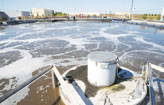Society
Sturgeon's death highlights threat to ancient fish
Updated: 2011-05-31 15:51
(Agencies)
TULCEA, Romania - Alas, poor Harald. Wired up to a satellite transmitter, he had much to teach science about the life of the great sturgeons of the Danube River and Black Sea.
His probable demise is a cautionary tale of the multiplying threats to the great sturgeons, sought since Roman times for the wealth they yield in meat and caviar.
Consider: A living creature from the age of the dinosaurs, a fish that can grow as long as a minibus, lives longer than most men, sniffs its way to its birthplace to spawn and can yield a fortune in caviar.
When in 2009 a team of Romanian and Norwegian researchers attached a satellite transmitter to Harald's 2.9 meter (9{-foot) body, they hoped the data beamed back would show them ways of halting the rapid drop in the sturgeons' numbers. But now the Beluga sturgeon is missing, presumed to be a victim of poachers.
Sturgeon have thrived in the Danube for 200 million years, migrating from feeding grounds in the Black Sea to Germany 2,000 kilometers (1,200 miles) upstream. Archaeologists have found wooden sturgeon traps in the ruins of Roman fortresses behind the willow trees on the Danube's banks, along with sturgeon bones dated to the 3rd century.
In the 1970s and '80s Romania built giant dams across the Iron Gates gorge, cutting off half the sturgeons' spawning grounds.
Fishermen caught them in huge numbers as they began their migration, trapping them before they could reproduce. Pollution from agricultural run-off and expanding cities put them under further pressure, although the construction of water treatment plants in the last decade has lessened the flow of filth.
Now environmentalists are trying to head off the latest threat: a European Union plan to deepen shipping channels in the Danube that they fear could eliminate the last shallows where the sturgeon deposit their eggs, which would doom the fish to vanish in its last stronghold in Europe.
"Right now it's teetering on the edge of extinction," said Andreas Beckmann, director of the Danube-Carpathian program of the Worldwide Fund for Nature, or WWF. "That one project, depending on how it's done, could push it over the edge."
Under the plan, engineers would block partially several side channels of the Danube and divert water to the main fairway, enabling year-round shipping through what are now low-water bottlenecks. Concrete would reinforce the banks of some islands.
European and Romanian officials insist the proposed action would not further endanger the fish in the wild, free-flowing waters of the Lower Danube.
"There will be enough water to ensure migration," said Serban Cucu, a senior Transport Ministry official and Romanian negotiator. Still, construction has been delayed for a year to allow more monitoring of the channels.
"If the data collected shows there is some influence, we will decide together whether to stop the project," said Cucu, interviewed in his Bucharest office.
Sturgeon, which can live a century or more in both salt and fresh water, are genetically wired to reproduce only where they themselves were born. Equipped with four nostrils, each fish sniffs its way to its birthplace, says researcher Radu Suciu.
E-paper

Tapping into the future
Foreign companies are investing in China's water industry as many predict a growing profit margin.
Headhunters ride on growth
Commercial property rides wave
Learning from the past
Specials

Cuisine central
London's Chinatown is helping diners appreciate full palate of Chinese food

Tying the knot
Danish couple's high-end macrame export business takes off in the mountains of Yunnan.

Truly a super woman
Li Yuchun first came to prominence in 2005 as the Super Girl winner, and since then has become an international star.

